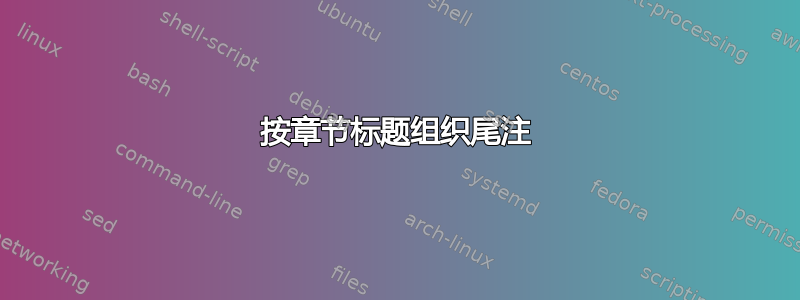
我正在尝试enotez按章节组织(“拆分”)我的尾注,并使用相关章节标题作为标题(最好居中),如下所示,并在标题中包含注释引用的分页(例如,第 25-37 页注释), 使用titlesec。
Notes
CHAPTER I: TeX
1. TeX is a typesetting system (or a "formatting system").
2. TeX was designed and mostly written by Donald Knuth.
CHAPTER 2: WYSIWYG
1. *WYSIWYG* stands for What You See Is What You Get.
2. The phrase implies a user interface that allows the user to view something very similar to the end result.
3. *WYSIWYG* means that the display simulates the appearance and represents the effect of fonts and line breaks on the final pagination using a specific printer configuration.
迄今为止的代码:
\documentclass[12pt, twoside, openright]{book}
\usepackage{blindtext}
\newcommand{\hsp}{\hspace{18pt}}
\usepackage[pagestyles]{titlesec}
\titleformat{\chapter}[hang]{\Huge\bfseries}{\thechapter\hsp}{0pt}{\Huge\bfseries}
\newpagestyle{main}{\sethead[\thepage][\textit{\thetitle}][] % even
{}{\textit{\chaptertitle}}{\thepage}} % odd
\pagestyle{main}
\usepackage{enotez}
\setenotez{backref=true, totoc, split=chapter, split-title={\MakeUppercase{\chaptername\ <ref>: <title>}}}
\NewSplitTitleTag{title}{\nameref{ch:<split-level-id>}}
\begin{document}
%frontmatter etc.
\mainmatter
\chapter{TeX}
When the second edition\endnote{TeX is a typesetting system (or a "formatting system").} was published, in 1976, the whole book had to be typeset again because the Monotype technology had been largely replaced by phototypesetting, and the original fonts were no longer available. When Knuth\endnote{TeX was designed and mostly written by Donald Knuth.} received the galley proofs of the new book on 30 March 1977, he found them inferior.
\chapter{WYSIWYG}
Modern software does a good job of optimizing the screen display for a particular type of output. For example, a word processor is optimized for output to a typical printer. The software often emulates the resolution of the printer in order to get as close as possible to WYSIWYG\endnote{WYSIWYG stands for What You See Is What You Get.}. However, that is not the main attraction of WYSIWYG\endnote{The phrase implies a user interface that allows the user to view something very similar to the end result.}, which is the ability of the user to be able to visualize what they are producing\endnote{WYSIWYG means that the display simulates the appearance and represents the effect of fonts and line breaks on the final pagination using a specific printer configuration}.
\backmatter
\cleardoublepage
\printendnotes
\addtocontents{toc}{\vspace{-0.5em}}
\end{document}
答案1
您可以使用类(报告文章类memoir的超集)及其自己的尾注功能。下面我修改了您的 MWE,以提供我认为您想要的内容。book,and
% endnotesprob.tex SE 535808
%\documentclass[12pt, twoside, openright]{book}
\documentclass[12pt, twoside, openright]{memoir}
\makepagenote % for memoir's endnotes
\usepackage{comment}
\usepackage{blindtext}
\newcommand{\hsp}{\hspace{18pt}}
\usepackage[pagestyles]{titlesec}
\titleformat{\chapter}[hang]{\Huge\bfseries}{\thechapter\hsp}{0pt}{\Huge\bfseries}
\newpagestyle{main}{\sethead[\thepage][\textit{\thetitle}][] % even
{}{\textit{\chaptertitle}}{\thepage}} % odd
\pagestyle{main}
%%%%%%%%%%%%%%%%%%%%%%%%
\begin{comment}
\usepackage{enotez}
\setenotez{backref=true, totoc, split=chapter, split-title={\MakeUppercase{\chaptername\ <ref>: <title>}}}
\NewSplitTitleTag{title}{\nameref{ch:<split-level-id>}}
\end{comment}
%%%%%%%%%%%%%%%%%%%%%%%
\begin{document}
%frontmatter etc.
\mainmatter
\chapter{TeX}
When the second edition\pagenote{TeX is a typesetting system (or a "formatting system").} was published, in 1976, the whole book had to be typeset again because the Monotype technology had been largely replaced by phototypesetting, and the original fonts were no longer available. When Knuth\pagenote{TeX was designed and mostly written by Donald Knuth.} received the galley proofs of the new book on 30 March 1977, he found them inferior.
\chapter{WYSIWYG}
Modern software does a good job of optimizing the screen display for a particular type of output. For example, a word processor is optimized for output to a typical printer. The software often emulates the resolution of the printer in order to get as close as possible to WYSIWYG\pagenote{WYSIWYG stands for What You See Is What You Get.}. However, that is not the main attraction of WYSIWYG\pagenote{The phrase implies a user interface that allows the user to view something very similar to the end result.}, which is the ability of the user to be able to visualize what they are producing\pagenote{WYSIWYG means that the display simulates the appearance and represents the effect of fonts and line breaks on the final pagination using a specific printer configuration}.
\backmatter
\cleardoublepage
% \printendnotes
\printpagenotes % for memoir's endnotes
\addtocontents{toc}{\vspace{-0.5em}}
\end{document}
为了避免与其他软件包冲突,memoir请使用宏\pagenote而不是\endnotefor 尾注。在序言中,您必须输入\makepagenoteget 尾注,并\printpagenotes在需要打印时使用 for。手册 ( texdoc memoir) 部分17.4 尾注描述了在正文和列表中调整尾注外观的多种方法。




